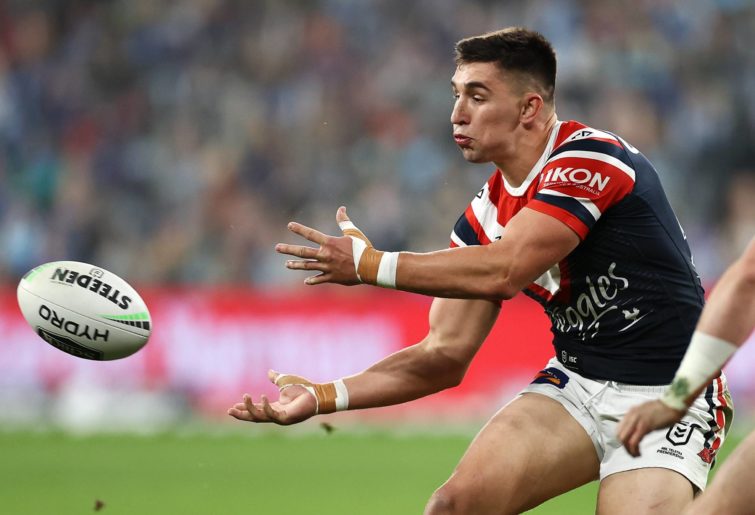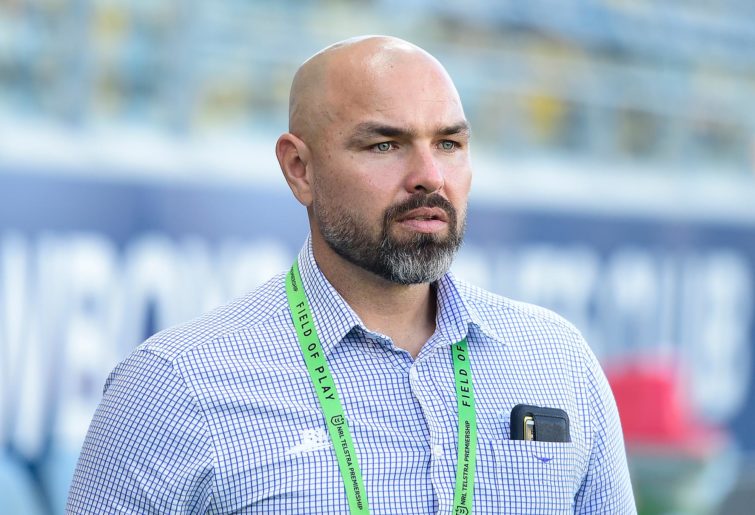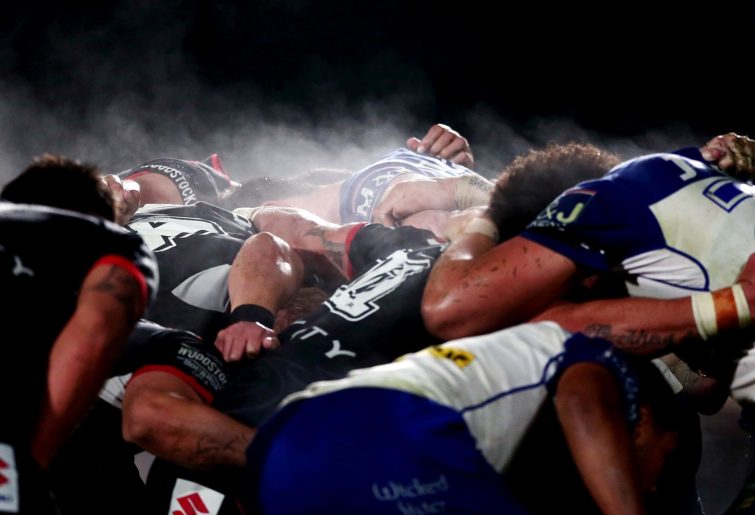The 2022 NRL season has begun with more of the on-the-run rule-tinkering that has become a trademark of the Peter V’Landys era. Early indications are that this iteration of the rule book is being received more positively than the 2021 version, but there is one particular change that is clearly going to take time to bed in.
In what appears on the surface to be an attempt to treat the concussion issue more seriously, the NRL has decreed that the power and responsibility for the removal of a concussed player shift from referees and the club doctor to an independent doctor.
At face value this would appear to be an obvious and long-overdue improvement; ensuring that club doctors aren’t pressured to allow concussed players to remain on the field. Lachlan Lewis and Sean Keppie were two well-publicised examples from last season of visibly concussed players not immediately being removed from play.
Like so many ideas that look good on a whiteboard, implementation has so far proved troublesome. It is interesting that problems have emerged on all sides of the issue, making it a difficult one for stakeholders to understand, let alone solve.
In Round 1 the Roosters’ Victor Radley was visibly shaken by a head clash and was attended to on the field before inexplicably being allowed to stay on the pitch. He was then involved in another tackle and packed a scrum before he was finally removed on the instruction of the independent doctor.
The flaw in the new system was immediately obvious: the NRL shifting the primary responsibility away from the club doctor and trainers has effectively allowed them to abrogate all of their responsibility to the independent doctor.
The independent doctor is located in a central off-field bunker. They view replays of incidents and make an assessment before passing their decision to the on-field officials. Depending on how many different angles they view and how long it takes to have those images presented to them, the referee can have restarted play before a decision is made and the player is summoned from the field either for a head injury assessment or to be automatically withdrawn from the game in line with the symptoms displayed.
It is doubtful that players, coaches, fans and media will accept lengthy delays in play while the off-site independent doctor makes these assessments. Yet it is grossly negligent to allow concussed players to continue because an initial evaluation process is yet to run its course.
An obvious solution is for the NRL to ensure that all parties – the independent doctor, referees, club doctors and the on-field trainers – work in unison with player safety as the priority. If trainers and club doctors will not immediately remove a player they suspect of having suffered concussion, then the NRL can easily take this out of their hands by having a second independent doctor on the sideline. Last year the NRL generated revenue of $575 million. They have the money.
If any player, coach or club official is found to be cheating the system, the NRL should be prepared to hit the club with sanctions that actually cut through. Loss of all competition points for the year would be a good starting point.

(Photo by Cameron Spencer/Getty Images)
Following the Roosters match where, in addition to Radley, centre Billy Smith was also withdrawn from play by the independent doctor, Roosters coach Trent Robinson was highly critical of the new process. Smith was eventually cleared to return, an outcome that reinforced to Robinson and Roosters fans that he shouldn’t have been withdrawn in the first place.
This position is problematic. It is highly unlikely that every single player withdrawn by the independent doctor will have suffered a concussion. It is probable that the majority will have. The price to be paid for erring on the side of caution is that the process will inadvertently capture some non-concussed players. That is surely preferable to the alternative of not capturing all concussed players.
In the discussion around measures implemented to improve player safety there has been a heavy focus around the potential for clubs to rort the system to achieve an unfair advantage by obtaining ‘free’ player interchanges. The prevalence of rorting was acknowledged by coach Robinson himself, who told Fox Sports, “It’s frustrating in the moment. They’ve made a call on how to get rid of the cheating of the system, which we all can acknowledge was there.”
In the Round 1 match between the Bulldogs and the Cowboys four Bulldogs – Chris Patolo, Brent Naden, Braidon Burns and Jeremy Marshall-King – were taken from the field for HIAs.
Cowboys coach Todd Payten blew up, suggesting the Bulldogs were abusing the system, slowing the game down to have players assessed and allowing them time to regroup while under pressure.

(Photo by Ian Hitchcock/Getty Images)
Setting aside the question of how anyone sitting in the stands could be certain that a player was concussed or not, it would seem remarkable that any side would fake four injuries so as to be left with no reserves in the final stages of the match.
The plot thickened, however, when the NRL formally asked the Bulldogs for a ‘please explain’ after it became apparent that Marshall-King had suffered a shoulder injury, not a head injury. The outcome is yet to be communicated publicly.
More chaos followed in Week 2 when Penrith’s Sean O’Sullivan was hit late by St George’s Jaydn Su’A, stayed down after contact and was attended to by his trainer.
With a hint of head-to-head contact and O’Sullivan grabbing at his head while down, it was no surprise to see the doctor remove him from the field. Cue a pile-on from commentators who insisted that the tackle wasn’t high or late, with Gorden Tallis even going so far as to insist that O’Sullivan had actually passed an initial on-field assessment with the trainer, but because the referee was wrong to have penalised Su’A, the officials conspired to have O’Sullivan removed, so as to save face.
If O’Sullivan was indeed feigning injury to ensure a penalty, he and other players will quickly realise that the cost to them will be likely removal from the field due to the independent doctor exercising a duty of care on their behalf. The point missed by Tallis and others, like Braith Anasta, in the follow-up is that the issue warrants a genuine approach on everyone’s part and far more gravitas than the spruiking of ridiculous conspiracy theories.
Adding to the confusion is a misconception – reinforced by commentators – with respect to the head injury assessment process.
An initial assessment made by the on-field trainer is not a ‘concussion test’ or HIA. The Penrith trainer who attended to O’Sullivan was merely comforting him and making his own initial assessment. The actual HIA is an off-field process that takes between 10 and 15 minutes to complete.
That HIA process is itself flawed and is a child of the global Concussion In Sport Group, which has recently come under scrutiny due to allegations of plagiarism and the discrediting of its figurehead, Dr Paul McCrory.
The HIA does not determine if a concussion has occurred; rather, it is an indicator of the existence of symptoms of concussion using baseline information gathered from players. Studies have revealed that players from multiple codes have ‘gamed’ the initial baseline test to help ensure that they do not fail a test during a match.
In that context the initial on-field assessment most certainly cannot determine if a player is concussed or not; the trainer is merely looking for basic signals. That said, if a player is so obviously concussed – if they exhibit any of a number of category 1 symptoms – that the need for an HIA is rendered superfluous, the on-field trainer still has an important role to play in assisting the injured player.
In 2021 the NRL announced changes to the return to play protocol, increasing the minimum stand-down period for concussed players to 11 days. This move helped reinforce to the public that the NRL is being cautious and has the safety of its players at heart.
In practice the 11-day minimum stand-down is a misleading signal. Players can and do return to play within a week. Both Radley and Smith were quickly cleared to play in Round 2, with coach Robinson stating that this was “because there was no concussion”.
In the case of Radley, this is a remarkable claim. How is it possible for Robinson or the club doctors to be certain? More accurately, what Robinson might have said was that Radley was no longer exhibiting any symptoms of concussion.

(Photo by Mark Metcalfe/Getty Images)
We now have a situation where the NRL is beginning to tentatively signal change with respect to concerns around concussion, being unsupported by coaches on one hand upset by opponents taking advantage of the safety measures, and on the other upset by having their own players taken off them.
Rugby league media seems equally confused, with multiple commentators reinforcing the need to do more to protect players while simultaneously complaining about overreactions and the game going soft.
As a result, the focus is too often on peripheral issues like faking and rorting and not on how to prevent players from continuing to suffer brain injuries.
Further still, there continues to be no discussion about the nature of rugby league and how the potential re-engineering of aspects of the game might allow for retention of the essence of the sport while making it safer to play.
A sport that already provides for four replacement players has found it necessary to add another because it has deemed that any side who runs out of players due to multiple concussions would be unfairly penalised.
In what universe can that logic and concern validly override questions around why so many concussions – read, brain injuries – are occurring in the first place?

(Anthony Au-Yeung/Getty Images)
In the UK awareness and acceptance of recent changes in the Super League have largely been positively received. How is it that rugby league in the UK – the ultimate working-class, hard man’s game – is able to make that cultural shift more easily than Australia?
Almost certainly this is because Great Britain is a small island and football and rugby union are already further down the road. High-profile lobby groups such as the Jeff Astle Foundation and Progressive Rugby have worked hard to ensure that the concussion issue is kept front and centre and that the issue is not just for individual sports alone to address but a problem for all of sport to own and solve.
The slogan ‘if in doubt, sit them out’ is now commonly understood and increasingly observed in the UK. That is exactly the kind of emphasis that needs to become part of the vernacular in Australian rugby league.
Despite floundering leadership on this issue, rugby league in Australia will eventually catch up. Concussion protocols in junior rugby league are comparatively sound and largely well observed. If the comments of readers and fans on these pages are any indication, that cultural shift is already well underway.
In the meantime be prepared for the NRL concussion circus to roll on.
































































































